PROXY MONITOR
REPORT
Winter 2011
New Database Reveals Shareholder Proposal Trends
A debate over the scope of voting rights for the shareholders of publicly traded corporations has been raging for the last several years.[1] In the policy arena, the Dodd-Frank financial-reform legislation,[2] enacted in July 2010, made substantial changes to the traditional rules that had limited shareholders' power over corporate governance. Unfortunately, much of the debate and policy discourse concerning corporate governance to date has been thinly informed as to how shareholder activism is actually playing out in practice. To help fill that gap, the Manhattan Institute has developed a new, open database that we are calling ProxyMonitor.org, which will facilitate research into the nature and characteristics of recent shareholder proxy proposals and the overall patterns and trends that they exhibit.
Background
Voting by proxy—i.e., by delegation—is how holders of the common stock of corporations, few of whom ever attend shareholder meetings, exercise their voting rights with respect to various questions of corporate governance.[3] Publicly traded corporations distribute proxy statements to shareholders, along with ballots asking them to vote on questions related to the election of directors, the appointment of independent auditors, and changes to the corporation's voting rules or structure. Shareholders may also propose proxy ballot questions, which management typically opposes. Both the sponsoring shareholder and management are afforded space on corporate proxy statements to summarize and expound their positions.
Some scholars and investors welcome these shareholder proposals and believe that it should be made easier for shareholders, through ballot initiatives, to influence corporate policy. Such proponents of expanded "shareholder democracy"[4] have attributed recent corporate failures to lapses in board oversight, and they contend that increasing shareholder voting power would improve corporate performance.
Critics of shareholder activism maintain that outside interest groups such as labor unions, whose pension plans are shareholders, have agendas often at odds with management's fiduciary duty to maximize value for all shareholders.[5] These critics, pointing to linkages among shareholder activists, trial lawyers, and issue-advocacy groups,[6] contend that proposals by outside shareholders frequently have social or political goals unrelated to issues of corporate governance.
Further elevating the importance of corporate-governance questions was the enactment of the Dodd-Frank Wall Street Reform and Consumer Protection Act, which "hands unprecedented rights to investors in the expectation that they will serve as a 'neighborhood watch' against corporate mismanagement."[7] Section 951 of Dodd-Frank creates new shareholder-advisory powers over executive-compensation packages, an area of focus in recent outside shareholder proposals. Section 971 enables the Securities and Exchange Commission (SEC) to issue regulations granting outside shareholders the ability to nominate directors to corporate boards on corporation-issued proxy ballots. (By a 3–2 vote, the SEC adopted rules whereby shareholders holding in the aggregate 3 percent or more of outstanding shares for at least three years can propose their own candidates for director on corporate proxy statements; the proposed rule is now stayed pending litigation).[8]
ProxyMonitor.org
Notwithstanding extensive debate over the proper role of shareholders in corporate governance, there has been limited empirical analysis of the actual pattern of shareholder-proposal activity.[9] Moreover, investors interested in learning about how particular industries are being challenged, as well as where those challenges originate, have had no central database to consult. To help fill this gap, the Manhattan Institute's new ProxyMonitor.org website assembles all the proposals made by the shareholders of the 100 largest American companies, as measured by revenues, in the last three years. Users can search the Proxy Monitor database by company, industry, proposal type, or principal sponsor of the proposal. Discovering the features of these proposals will allow researchers to analyze trends in the shareholder-proposal phenomenon.
This report gives preliminary answers to the following questions:
- Which companies are the most frequent recipients of shareholder proposals?
- Who are the primary sponsors of outside-shareholder proposals?
- What types of shareholder proposals are being submitted, and what types of proposals are likely to be adopted?
- What trends can be observed in the incidence of shareholder proposals, and has there been any change in their likelihood of success?
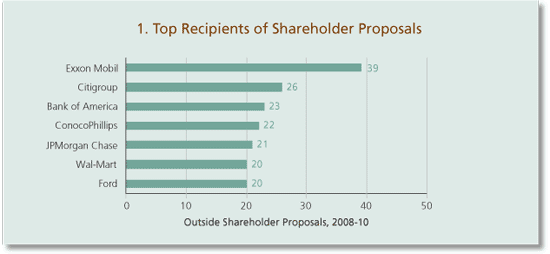 Which companies are the most frequent recipients of shareholder proposals?
Which companies are the most frequent recipients of shareholder proposals?
As shown in graph 1, the most frequent recipients of shareholder proposals tend to be some of the very largest American companies: oil companies ExxonMobil and ConocoPhillips; banking companies Citigroup, JPMorgan Chase, and Bank of America; retail giant Wal-Mart; and Ford Motor Company. While this grouping would tend to suggest that energy and financial companies are more likely to be the targets of shareholder activists, there is little else that can be discerned absent a fuller statistical analysis. (To be sure, the companies' stock performance has varied widely, with companies such as Wal-Mart and Ford dramatically outperforming their peer group and market indices, while others such as Citi and Bank of America among the worst-performing of those companies buffeted by the recent financial crisis.)
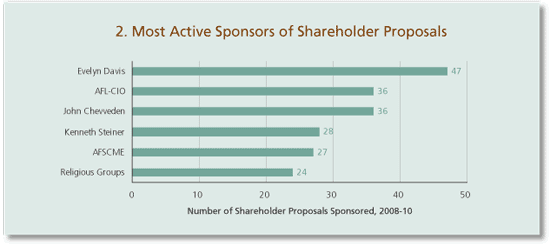 Who are the primary sponsors of shareholder proposals?
Who are the primary sponsors of shareholder proposals?
As shown in graph 2, the six most active sponsors of outside-shareholder proposals are not hedge funds or large institutional investors but rather certain individuals (often called corporate gadflies); certain labor unions; and certain religious groups and other issue-advocacy organizations. More than 10 percent of all shareholder proposals in the 2008–10 period were sponsored by shareholder activists John Chevveden, Kenneth Steiner, and Evelyn Davis. More than 5 percent of all proposals were sponsored by two labor unions: the AFL-CIO; and the American Federation of State, County, and Municipal Employees (AFSCME).
What types of shareholder proposals are being submitted, and what types of proposals are likely to be adopted?
As shown in graph 3, a plurality of all shareholder proposals—38 percent—concern themselves with social policy, not corporate governance or executive compensation. As shown in graph 4, however, none of these social-policy proposals was approved by a majority of shareholders in the last three years. Seven percent of proposals related to executive compensation were approved. (With one exception, all these proposals required shareholder-advisory votes on compensation. Under Dodd-Frank, such shareholder advisory votes on pay packages are now mandatory for all public companies.) Nineteen percent of proposals related to traditional corporate-governance issues were approved over the same time period. Most of the successful proposals called for a simple majority vote of shareholders to elect directors or authorized shareholders to call special meetings.
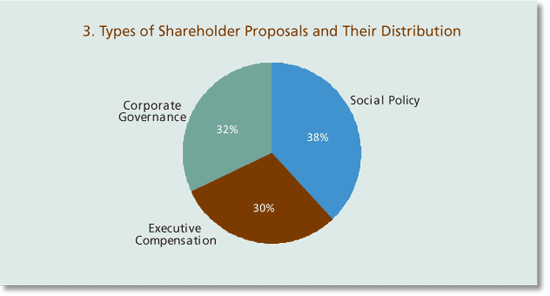
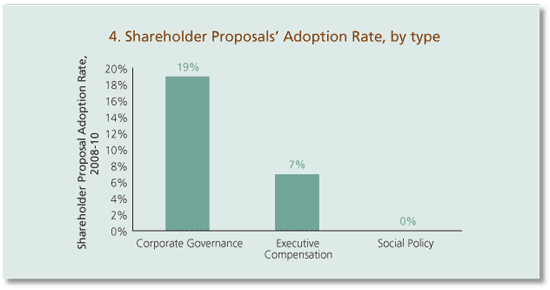
What trends can be observed in the incidence of shareholder proposals, and has there been any change in their likelihood of success?
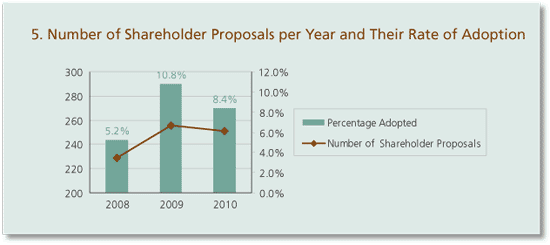 As shown in graph 5, the volume of outside shareholder proposals rose almost 12 percent from 2008 to 2009, before leveling off. The increase in the number of proposals might have been even more pronounced had past successes in passing proposals on "say-on-pay," majority voting, and special-meeting rules not obviated the need for advocates of such proposals to reintroduce them. Shareholder proposals' probability of passage more than doubled, from 5.2 percent in 2008 to 10.8 percent in 2009, before declining slightly (as of November) in 2010. The increased success in passage rates in 2009 may be at least partly attributable to the 2008 financial collapse; the decline in 2010 may be due to market stabilization or to the passage of more popular proposals in the preceding years, thus removing such proposals from the group confronting shareholders.
As shown in graph 5, the volume of outside shareholder proposals rose almost 12 percent from 2008 to 2009, before leveling off. The increase in the number of proposals might have been even more pronounced had past successes in passing proposals on "say-on-pay," majority voting, and special-meeting rules not obviated the need for advocates of such proposals to reintroduce them. Shareholder proposals' probability of passage more than doubled, from 5.2 percent in 2008 to 10.8 percent in 2009, before declining slightly (as of November) in 2010. The increased success in passage rates in 2009 may be at least partly attributable to the 2008 financial collapse; the decline in 2010 may be due to market stabilization or to the passage of more popular proposals in the preceding years, thus removing such proposals from the group confronting shareholders.
Conclusion
Preliminary examination of proxy statements from the 100 largest companies suggests that at least some of the critiques of shareholder activism have merit: a substantial percentage of shareholder proposals have little to do with corporate performance or increasing share value. Issue-advocacy groups with social agendas that go beyond shareholder protection as well as labor unions with interests that sometimes conflict with those of the average shareholder are major sponsors of shareholder proposals. Also striking is the large role in shareholder activism played by "corporate gadflies," individuals who repeatedly initiate shareholder proposals despite having only small holdings in a wide variety of companies. Further analysis of the Proxy Monitor data, along with the expansion of the database's offerings, will allow a more probing exploration of these issues.
ENDNOTES
- This area of discussion dates back to Adolph Berle and Gardiner Means's The Modern Corporation and Private Property (1932) and is exhaustively explored in the corporate-law literature.
- The Dodd-Frank Wall Street Reform and Consumer Protection Act, Pub.L. 111-203, H.R. 4173 (2010).
- Unlike debt holders and other stakeholders in corporations, holders of common stock lack the ability to contract with the corporation to protect their interests. Common shareholders' main mechanism for protecting their interests, other than selling their shares, is their ability to elect directors and vote on other matters concerning the corporation. They are also protected by the exercise of the fiduciary duties that officers and directors owe them.
- See, e.g., Lucian A. Bebchuk, The Myth of the Shareholder Franchise, 93 Va. L. Rev. 675 (2007); Lucian A. Bebchuk, The Case for Increasing Shareholder Power, 118 Harv. L. Rev. 833 (2005). Bebchuk's position is opposed most vigorously by Stephen Bainbridge, a critic of "shareholder rights" theories, who endorses a "director primacy" model of corporate governance. See, e.g., Stephen M. Bainbridge, Director Primacy: The Means and Ends of Corporate Governance, 97 Nw. U. L. Rev. 547 (2003); Stephen M. Bainbridge , The Board of Directors as Nexus of Contracts, 88 Iowa L. Rev. 1 (2002).
- See, e.g., Manhattan Institute for Policy Research, Trial Lawyers, Inc.: California12-13(2005), available at http://www.triallawyersinc.com/ca/ca06.html.
- See, e.g., Jonathan Drimmer, Think Globally, Sue Locally: Out-of-Court Tactics Employed by Plaintiffs, Their Lawyers, and Their Advocates in Transnational Tort Cases(2010), available at http://www.instituteforlegalreform.com/images/stories/documents/pdf/international/thinkgloballysuelocally.pdf.
- Ira Millstein & Stephen Davis, Finally, Governance Becomes Possible (2010), available at http://millstein.som.yale.edu.
- See Jesse Westbrook, SEC Delays Proxy-Access Rules amid Legal Challenge, Bloomberg Businessweek, Oct. 4, 2010, available at http://www.businessweek.com/news/2010-10-04/sec-delays-proxy-access-rules-amid-legal-challenge.html.
- But see, e.g.,Yonca Ertimur et al., Board of Directors' Responsiveness to Shareholders: Evidence from Shareholder Proposals, 16 J. Corp. Fin. 53 (2010); Joao Dos Santos & Chen Song, Analysis of the Wealth Effects of Shareholder Proposals (2009), available at http://secure.uschamber.com/wfi/Analysis_of_the_Wealth_Effects_of_Shareholder_Proposals_Volume_II.pdf; Sunil Wahal, Pension Fund Activism and Firm Performance, 31 J. Fin. Quantitative Analysis1 (1996); Jonathan M. Karpoff et al., Corporate Governance and Shareholder Initiatives: Empirical Evidence, 42 J. Fin. Econ. (1996).